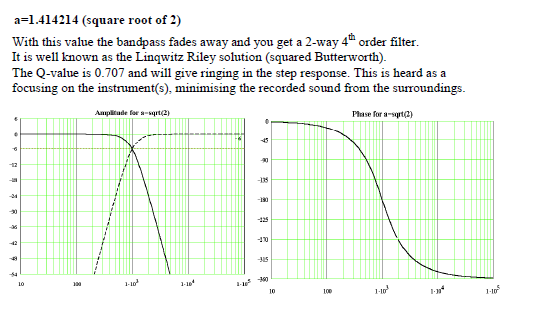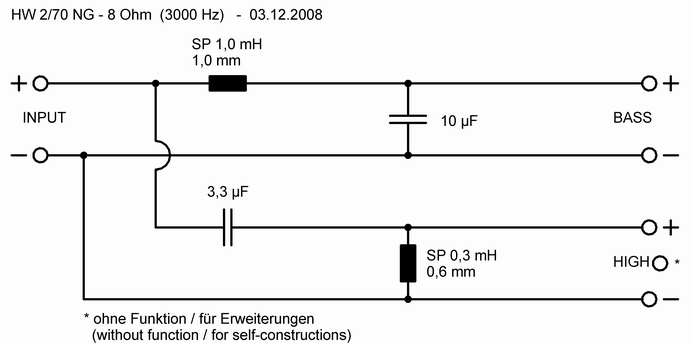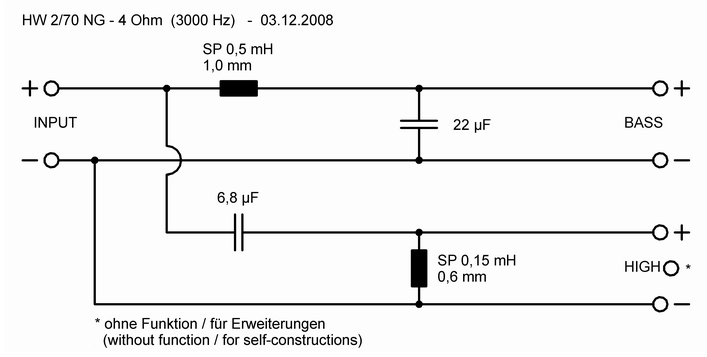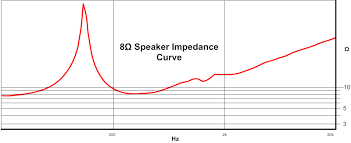Hi, I'm new and I'm very very confused for that situation in Tannoy crossover design:
Two way Saturn series bookshelf speaker. I'm looking the circuit. In crossover low and high pass filters design for same frequency like 2000hertz. one of them is upper and other lower frequency but they are same in all crossover designs.
In my bookshelf crossover highpass frequency (they are parallel) 5000hertz and low passfilter was ~ 2000 (1760) hertz. It series, high 5,6uf & 0.14mH, low 6,8uf and 1,2mH LC filters.
I all read that in crossovers they must be the same frequency in design. Why Tannoy made like this crossover, is it useal? there is no that kind of crossover design in my search. thx,
Two way Saturn series bookshelf speaker. I'm looking the circuit. In crossover low and high pass filters design for same frequency like 2000hertz. one of them is upper and other lower frequency but they are same in all crossover designs.
In my bookshelf crossover highpass frequency (they are parallel) 5000hertz and low passfilter was ~ 2000 (1760) hertz. It series, high 5,6uf & 0.14mH, low 6,8uf and 1,2mH LC filters.
I all read that in crossovers they must be the same frequency in design. Why Tannoy made like this crossover, is it useal? there is no that kind of crossover design in my search. thx,
The capacitor and inductor values are only the same in each branch of a 2-way crossover in an ideal text book situation.I all read that in crossovers they must be the same frequency in design.
Using on-line crossover calculators, where you simply enter the same impedance for the bass and treble drivers, results in this ideal result. This is what member 6L6 is drawing your attention to.
In practice, crossover components are tailored by the likes of Tannoy to match the individual impedances of the drivers at the frequency of crossover.
Scroll down to 'Designing Loudspeaker Crossovers' in this link for an answer to your question. Humble Homemade Hifi - Crossover Design
The capacitor and inductor values are only the same in each branch of a 2-way crossover in an ideal text book situation.
Using on-line crossover calculators, where you simply enter the same impedance for the bass and treble drivers, results in this ideal result. This is what member 6L6 is drawing your attention to.
In practice, crossover components are tailored by the likes of Tannoy to match the individual impedances of the drivers at the frequency of crossover.
I was measured the resistance as 4ohms both. But, I don't now the empedance. now I measured the inductance t:0.2mh and w: 0.358mh. Do you think reason is the difference in empedance! all calculators asks resistance of speaker. If so...
The Saturn is unfortunately an example of a bad xover implementation. I have a pair. Tannoy went through a period of trying to pander to the home theater crowd with deliberate mis-engineering. The response is V-shaped. You could try a simple mod by reducing the cap value in the bass filter. However, the horn nature of the tweeter means the balance with the bass driver is not straight forward. The drivers are well made units with good power handling.
There were many models of the Tannoy Saturn... so advice depends on circumastances.
The theory looks like this to integrate two drivers:

Actually incomplete, because real speakers have a bass boost called bafflestep to give correct loudness to the bass. Linkwitz-Riley uses different filter frequencies on the two drivers.
An off-the-shelf 8 ohm crossover looks like this:

A 4 ohm looks like this:

Crossovers | Visaton
You'd be lucky if that 8 ohm one works well with most speakers, and it would need some resistors for level. Might be OK with a 4 ohm bass IMO.
The theory looks like this to integrate two drivers:
Actually incomplete, because real speakers have a bass boost called bafflestep to give correct loudness to the bass. Linkwitz-Riley uses different filter frequencies on the two drivers.
An off-the-shelf 8 ohm crossover looks like this:
A 4 ohm looks like this:
Crossovers | Visaton
You'd be lucky if that 8 ohm one works well with most speakers, and it would need some resistors for level. Might be OK with a 4 ohm bass IMO.
Try to read the information in my earlier link - it tells you what you need to know.I was measured the resistance as 4ohms both. But, I don't now the empedance. now I measured the inductance t:0.2mh and w: 0.358mh. Do you think reason is the difference in empedance! all calculators asks resistance of speaker. If so...
The total opposition to alternating current, or impedance, of a loudspeaker driver is the sum of its DC resistance and its inductive reactance, both of which are measured in ohms.
Now, the impedance of a loudspeaker driver is not a fixed value since the inductive reactance part varies with frequency.
Loudspeaker designers have to measure the exact impedance of the driver at the crossover frequency. The nominal impedance figure (e.g. 8 ohm) given in the specifications is only given as a rough guide to aid your purchase.
Attachments
I want to design a crossover for my diy speaker&box. I ref. the tannoy RX1. Yes,it's not good speaker,I'm not using it. bec. I have revolution series speakers. Rev. series speakers have 3. order crossover, I want to use 2nd (easy).
Now, I understand that speakers in rx1 is not both 4 ohms. And I have an outcome if we don't measure real empedance of speakers (depends frequency also), it's not easy to find values from crossover calculators, we try to test some values. Calculator only may be a ref. only.
Talk with you very usefull for me. thank you,
Now, I understand that speakers in rx1 is not both 4 ohms. And I have an outcome if we don't measure real empedance of speakers (depends frequency also), it's not easy to find values from crossover calculators, we try to test some values. Calculator only may be a ref. only.
Talk with you very usefull for me. thank you,
I want to design a crossover for my diy speaker&box. I ref. the tannoy RX1. Yes,it's not good speaker,I'm not using it. bec. I have revolution series speakers. Rev. series speakers have 3. order crossover, I want to use 2nd (easy).
Now, I understand that speakers in rx1 is not both 4 ohms. And I have an outcome if we don't measure real empedance of speakers (depends frequency also), it's not easy to find values from crossover calculators, we try to test some values. Calculator only may be a ref. only.
Talk with you very usefull for me. thank you,
Always pleased to help. But, I am not even finding the Tannoy speaker model here.
Is this Tannoy Saturn or Tannoy Revolution R1?
The useful measurement is resistance of the bass, which is usually measured across the input plugs of the speaker with a multimeter. And the resistance of the tweeter which is best measured with the tweeter disconnected.
I realize English isn't your first language, so you are a brave man. We will help. It may be the tweeters are getting old and need some new ferrofluid. Perhaps some photos might help. You can upload them with the paperclip symbol in the reply box. 😎
There's lots to learn in relation to crossover design, this is Steve's area of expertise. I'm glad to have helped you with the impedance issue.Talk with you very usefull for me. thank you,
Thanks for your thanks!
Always pleased to help. But, I am not even finding the Tannoy speaker model here.
Is this Tannoy Saturn or Tannoy Revolution R1?
Sorry I wrote all wrong, it's mercury mx1. I'm sleeping 🙂
Hmm, so we start again with the correct speaker... 😀
Actually looks rather a nice example of the 5" plus 1".
I'd only say that this sort of thing doesn't go too loud or very deep. Otherwise a pleasant sort of small room speaker.
Actually looks rather a nice example of the 5" plus 1".
I'd only say that this sort of thing doesn't go too loud or very deep. Otherwise a pleasant sort of small room speaker.
Tannoy mx1 is really good speaker. I bought very cheap 🙂 I used, later I bought a mx2. I make small crossover tweet, I changed the 3.3ohm resistance which is series to tweeter to 2.2ohm, all capacitors tested, they are good condition. And I'm writing here due to I add a RC filter as paralel to crossover input 100nf + 10ohm for empedance (compancation? 🙂. I read somewhere I don't remember.
Result is not bad. in a time I'm using it, speaker sounds much better, perhaps after using 1,2 mounth. Now I like it.
I tested with naim 250 clone, L12-2, Technics and NAD c352, Audio Research amplifier. Perhaps later I will look for a new speaker but, I afraid that, it will be not better than my Tannoy MX1 🙂
What do you think about the RC filter?
Result is not bad. in a time I'm using it, speaker sounds much better, perhaps after using 1,2 mounth. Now I like it.
I tested with naim 250 clone, L12-2, Technics and NAD c352, Audio Research amplifier. Perhaps later I will look for a new speaker but, I afraid that, it will be not better than my Tannoy MX1 🙂
What do you think about the RC filter?
An impedance equalization circuit (Zobel circuit) would be placed after the crossover components. It's best connected directly across the bass driver terminals.I'm writing here due to I add a RC filter as paralel to crossover input 100nf + 10ohm for empedance (compancation? 🙂.
What do you think about the RC filter?
Is that what you have done?
Speaker Zobel / Impedance Equalization Network Circuit Calculator
The R and C values have to be calculated to suit both the DC resistance and the inductance of the driver's voice coil.
Last edited:
"To improve the impedance match and reduce the reflections that are
caused by an unterminated transmission line, some (but all too few)
vendors recommend a Zobel network - a resistor and capacitor in series,
typically 10 ohms and 100nF. This, they tell you, should be installed
at the speaker end of the cable. The usefulness of this is not always
optimal as will be shown later in this article, but in most sensible
cable constructions, it will do no harm. For some of the more exotic
constructions, a far-end Zobel is essential, however some may be poorly
designed." Loudspeaker Cable Characteristic Impedance
Not the same Zobel network, isn't it?
caused by an unterminated transmission line, some (but all too few)
vendors recommend a Zobel network - a resistor and capacitor in series,
typically 10 ohms and 100nF. This, they tell you, should be installed
at the speaker end of the cable. The usefulness of this is not always
optimal as will be shown later in this article, but in most sensible
cable constructions, it will do no harm. For some of the more exotic
constructions, a far-end Zobel is essential, however some may be poorly
designed." Loudspeaker Cable Characteristic Impedance
Not the same Zobel network, isn't it?
- Home
- Loudspeakers
- Multi-Way
- Tannoy crossover fact
